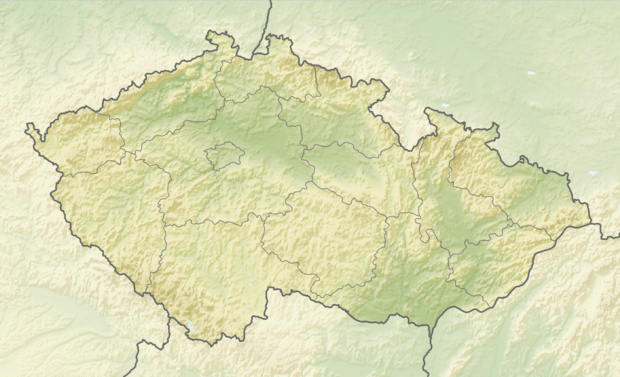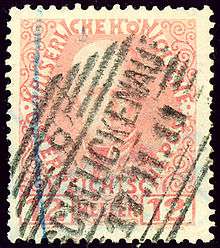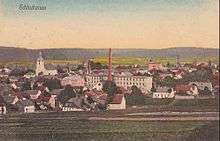Šluknov
Šluknov (Czech pronunciation: [ˈʃluknof]; German: Schluckenau) is the northernmost town of the Czech Republic in its Ústí nad Labem Region. It lies in the geographic region that shares its name, the Šluknov Hook (German: Schluckenauer Zipfel; Böhmisches Niederland), a small portion of Bohemia which lies between Saxon Switzerland (German: Sächsische Schweiz) and the Zittau Hills (German: Zittauer Gebirge). The district of Rožany (Rosenhain) has a border crossing to Sohland an der Spree. It is situated at 347 m above sea level and it has a population of around 5,500.
Šluknov | |
|---|---|
Town | |
 Šluknov Castle | |
 Flag  Coat of arms | |
 Šluknov Location in the Czech Republic | |
| Coordinates: 51°0′14″N 14°27′10″E | |
| Country | Czech Republic |
| Region | Ústí nad Labem |
| District | Děčín |
| Government | |
| • Mayor | Eva Džumanová |
| Area | |
| • Total | 47.48 km2 (18.33 sq mi) |
| Elevation | 340 m (1,120 ft) |
| Population (2019-01-01[1]) | |
| • Total | 5,615 |
| • Density | 120/km2 (310/sq mi) |
| Time zone | UTC+1 (CET) |
| • Summer (DST) | UTC+2 (CEST) |
| Postal code | 407 77 |
| Website | www.mesto-sluknov.cz |
History

Early history
During the middle of the 14th Century, on the site of the city, a Slavic settlement named Slanknov was established by the noble family of Berka z Dubé. The family's coat of arms is, to this day, the inescutcheon in the city's coat of arms.
Schluckenau was struck, in 1710 and 1830, by two large city fires. In 1813, the city was plundered by a 200,000 man army during the Napoleonic wars.
Until 1918, SCHLUKENAU (Schluckenau since the end of the 19th century) was part of the Austrian monarchy (Austria side after the compromise of 1867), head of the district of the same name, one of the 94 Bezirkshauptmannschaften in Bohemia.[2]
Nazi era
In 1930, Schluckenau was home to 5578 inhabitants who were largely ethnic German. Prior to the Second World War, Schluckenau was a center in Czechoslovakia for the pro-Nazist Sudeten German Party (SdP) led by Konrad Henlein. This was one reason why, in March 1939,[3] Adolf Hitler chose the city as the first stop of the Wehrmacht during the German annexation of Sudetenland. The Wehrmacht continued on to occupy Prague and establish the Protectorate of Bohemia and Moravia.
Following the invasion by the Wehrmacht some Czechs were driven out of Schluckenau into the interior of Bohemia. From 1938 until 1945 Schluckenau was the seat for the district administrator of the County of Schluckenau in the Nazist German Sudetenland, the district of Aussig (Czech: Ústí nad Labem).
Modern history
After the war, in 1945, the town returned to Czechoslovakia and the German livers were expelled under the terms of Beneš decrees. The city was renamed Šluknov. Only a few Czechs were willing to settle in the remote northern Bohemian town following its .
Roma
Today, the city and the Šluknov region are a problem area for the Czech Republic. The population is only 1/7 of its prewar size. One fifth of the residents are Romani who suffer from a high unemployment rate.
Landmarks

In the past, Schluckenau was the seat of power for the German nobile family Starschedel, who were Saxons and loyal to the Electorate of Saxony. Built in the 16th Century, the Šluknov castle was burned in 1986. Its reconstruction had to be postponed due to lack of funding after 1990. The work resumed in 2000 and the renovation is now completed. In addition to exhibition and event rooms located in the building there is a tourist information office. The park adjacent to the castle is often used for public events.[4]
The burial sites of the brothers Franz and Edward Bienert, North Bohemian historians, can be found in Šluknov. The brother fell victim to murder on 16 September 1990.[5]
References
- "Population of municipalities of the Czech republic". Czech Statistical Office. Retrieved 2019-04-30.
- Die postalischen Abstempelungen auf den österreichischen Postwertzeichen-Ausgaben 1867, 1883 und 1890, Wilhelm KLEIN, 1967
- Not in October 1938, as other parts of the Sudetenland??
- "Šluknov - nejsevernější město v ČR".
- "Archived copy". Archived from the original on 2011-07-18. Retrieved 2010-11-15.CS1 maint: archived copy as title (link)